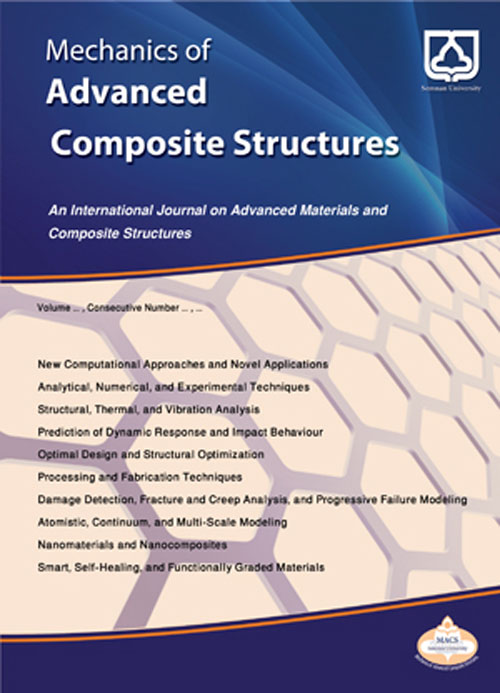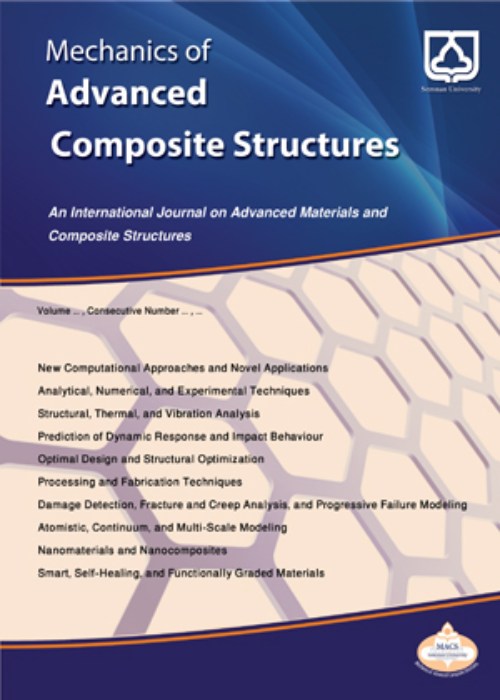فهرست مطالب

Mechanics of Advanced Composite Structures
Volume:3 Issue: 1, Spring and Summer 2016
- تاریخ انتشار: 1395/05/16
- تعداد عناوین: 7
-
-
Pages 1-7One of the greatest impediments to use polymer-matrix composites is their susceptibility to degradation when exposed to the elevated temperatures and the limited knowledge on the thermal and mechanical properties of these composites at such temperatures. The objective of this study is to evaluate the effects of accelerated heat aging on the tensile properties of the Woven Basalt/Phenolic (WBP) composites. Mechanical tests are performed on the specimens, which have previously been subjected to the accelerated heat aging conditions. The specimens were exposed to the constant temperatures in the range of 150 °C, 200 °C and 250 °C for various periods of times, and then, the residual tensile properties were measured at room temperature. The specimens were isothermally heated for 1, 2, 5, and 10 hours at the said temperatures and then left to cool naturally to the ambient temperature of about 25 °C. Both the tensile modulus and the ultimate tensile strength of WBP composites decreased with elevated temperatures and these degradations were time and temperature dependent.Keywords: Polymer, matrix composites, Accelerated heat aging, Basalt fiber, Phenolic resin, Tensile properties
-
Pages 9-13Due to the high cost of experimental analyses, researchers used atomistic modeling methods for predicting the mechanical behavior of the materials in the fields of nanotechnology. In the pre-sent study the Self-Consistent Charge Density Functional Tight-Binding (SCC-DFTB) was used to calculate Young's moduli and average potential energy of the straight and curved graphenes with different curvature widths under axial strain. Also, this method was used to determine the magnitude of the curvature on the aforementioned mechanical properties. From the results it can be concluded that Young's moduli of straight graphene is equal to 1.3 TPa and this mechanical property decreases slowly by decreasing the curvature width of graphenes. Also, the average potential energy and Young's modulus of graphenes decrease with increasing the number of curvature. In next section the Young's moduli of one-atom vacancy and two-atom vacancy defect were calculated and it was found that this mechanical property decreased with increasing the number of atom vacancy in the curved graphene.Keywords: Curved graphene, Density functional tight, binding, Defect, Young's modulus
-
Dynamic Stiffness Method for Free Vibration of Moderately Thick Functionally Graded PlatesPages 15-30In this study, a dynamic stiffness method for free vibration analysis of moderately thick function-ally graded material plates is developed. The elasticity modulus and mass density of the plate are assumed to vary according to a power-law distribution in terms of the volume fractions of the constituents whereas Poissons ratio is constant. Due to the variation of the elastic properties through the thickness, the equations of motion governing the in-plane and transverse deformations are initially coupled. Using a new reference plane instead of the mid-plane of the plate, the uncoupled differential equations of motions are derived. The out-of-plane equations of motion are solved by introducing the auxiliary and potential functions and using the separation of variables method. Using the method, the exact natural frequencies of the Functionally Graded Plates (FGPs) are obtained for different boundary conditions. The accuracy of the natural frequencies obtained from the present dynamic stiffness method is evaluated by comparing them with those obtained from the methods suggested by other researchers.Keywords: Dynamic stiffness method, Free vibration, Functionally graded material, First, order shear deformation theory, Exact solution
-
Precision Closed-form Solution for Out-of-plane Vibration of Rectangular Plates via Trigonometric Shear Deformation TheoryPages 31-43In this study, the new refine trigonometric shear deformation plate theory is used to study the out-of-plane vibration of the rectangular isotropic plates with different boundary conditions. The novelty of the research is that the analytical precision closed-form solution is developed without any use of approximation for a combination of six different boundary conditions; specifically, two opposite edges are simply supported hard and any of the other two edges can be simply supported hard, clamped or free. The equations of motion and natural boundary conditions, using Hamiltons principle are derived. The present analytical precision closed-form solution can be obtained with any required accuracy and can be used as benchmark. Based on a comparison with the previously published results, the accuracy of the results is shown. Finally, the effect of boundary conditions, variations of aspect ratios and thickness ratios on natural frequency parameters is shown and the relation between natural frequencies for different plates is examined and dis-cussed in detail.Keywords: Vibration, Precision closed, form solution, Trigonometric shear deformation theory
-
Pages 45-51Powder Injection Molding (PIM) is a precision manufacturing process used for production of advanced composites. Mixing of polymeric binder with metal powders, molding of feedstock, de-binding of brown parts and sintering of green samples are four main steps of this process. In the present study, the compounds containing multi-component binder system and aluminum/ nano-alumina (0-9 wt.%) powders were prepared and used as feedstock. After that, the feed-stocks were injected, de-bound and sintered for producing standard specimens. Finally, the sintered composites were produced with a maximum relative density of 97.7%. Afterward, the hardness, yield and ultimate tensile strength of the nano-composites were evaluated. The results showed that the relative density, hardness and strength of the manufactured composites increased due to the addition of nano-reinforcements. It is demonstrated that the effect of alumina on the density of PIM composites differs from that of conventional powder metallurgy. Scanning Electron Microscope (SEM) reveals that the agglomeration takes place in the sample containing 9 wt.% nano-alumina.Keywords: Aluminum matrix composite, Nano, reinforcement, Powder injection molding, Mechanical properties
-
Pages 53-62In this study, the effect of finite strain on bending of the geometrically nonlinear of micro laminated composite Euler-Bernoulli beam based on Modified Couple Stress Theory (MCST) is studied in thermal environment. The Green-Lagrange strain tensor according to finite strain assumption and the principle of minimum potential energy is applied to obtain governing equation of motion and boundary conditions. The equation of motion with boundary conditions is solved using a generalized differential quadrature method and then, the deflection of the beam in classical elasticity and MCST states is drawn and compared with each other. Considering the bending of the beam, which has been made of carbon/epoxy and glass/epoxy materials specified, it can be seen there is a significant difference between the finite strain and von-Karman assumptions particularly for L =10 h. Also, the results show that the thermal loadings have a remarkable effect on the glass/epoxy beam based on the finite strain particularly for simply supported boundary condition.Keywords: Size, dependent, Finite strain, Modifided couple stress theory, Laminated composite
-
Pages 63-71In the current study the effect of nanoclay content and carbon fiber orientation on the buckling properties of epoxy/nanoclay/ carbon fiber orientation is investigated. Buckling samples were prepared with 1, 3 and 5 wt% of nanoclay and 0, 30 and 45 degrees of fiber orientations based on VARTM technique. The results obtained from the buckling tests showed that adding 1wt% of nanoclay into the pure epoxy in different fiber orientations decreased the magnitude of critical buckling loads and the stress of starting the buckling process. Furthermore, in a constant fiber orientation, increasing the weight percentage of nanoclay increased the magnitude stress of starting the buckling process and the critical buckling load and then decreased them. Moreover, in-creasing the degree of fiber orientation decreased the buckling loads properties generally. The maximum values of stress of starting the buckling process and critical buckling load were 68.16 Mpa and 3.697 kN respectively which occurred with 3 wt% of nanoclay and 0 degree of fiber orientation.Keywords: Carbon fiber, Laminates, Hybrid, Mechanical properties, buckling


